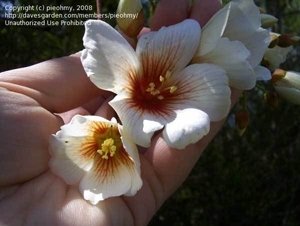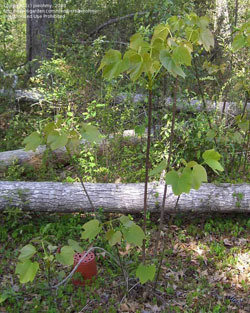





Memories of Granddaddy?s tung-oil tree orchard are favorites in my repository of childhood recollections. I recall running among the trees on Sunday afternoons with my cousins. We played war games in their shade, and our weapons of choice were the tung-oil nuts. It took only one or two good hits before we girl cousins threw up the white flag of surrender.
We played among the trees until our parents discovered what we were doing. By then we had whelps and bruises to show for our war, and our skin was stinging from contact with the tree and its leaves. We did not know at the time that all parts of the tree were extremely poisonous. Fortunately, none of us attempted to eat the fruits. A single seed is reputedly fatal to a human. The tung-oil trees in Granddaddy's orchard are mostly gone now. Even during his lifetime, the land was returned to pasture for his cattle. He grew the trees as a commercial crop and harvested the oil-rich seeds.
The tung-oil (tung oil, tung, tung nut or China-oil tree) (Vernicia fordii syn. Aleurites fordii) is deciduous and can grow to 40 feet tall. Like some other members of the Euphorbiaceae (spurge) family, the stems and smooth bark ooze a white latex substance if broken or injured. Distinctive leaves are mostly heart-shaped but sometimes have three shallow lobes. A distinguishing feature is a conspicuous red gland at the base of each leaf. Trees are particularly handsome during the spring when loose terminal clusters of white flowers with rose colored centers bloom before the leaves emerge. Later in the summer spherical to pear-shaped green fruits are formed that gradually turn dark purple to black as the fruits mature. Each fruit contains four to five seeds.
 History
History
During World War II, farmers in Mississippi, Florida, and other Gulf States were encouraged to grow tung-oil trees because the oil could be used as motor oil after the gums were removed from it. However, after a few hurricanes and hard frosts, many of the trees growing in Gulf States died. Hurricane Camille in 1969 wiped out many of the plantations. Susceptibility to frost damage has largely restricted cultivation to frostfree areas of China and South America.
While tung trees did not prove to be a reliable industry in most parts of the United States, some trees from the old plantations remain in areas where they successfully compete for resources with native species. Fruits can form when the trees are only two to four years old and the seeds sprout prolifically. Trees can also spread from suckers that form on underground stems, and they are adaptable to a wide range of environmental conditions.
In Florida, the tung-oil tree is listed as a Category II exotic invasive. Naturalized populations can be found near Tallahassee, Gainesville, and Mariana. Cumberland Island in Georgia also has a naturalized population of the trees. In areas where tung-oil trees are problematic, people are encouraged to remove them from the landscape, preferably before seeds are produced.
Uses
Tung oil is derived from the seeds of the tung-oil tree. It is the traditional oil of the Chinese lantern, so one can well imagine that it was the oil that burned in Aladdin's lamp. Today it is used as a finish for furniture and wooden objects, as an ingredient in paint, varnish, and caulk, and in linoleum, oilcloth, polishing compounds, and other products. The strong, lightweight wood is sometimes used as a substitute for balsa or basswood.
Tung oil makes a tough, flexible, highly water-resistant coating. That, of course, makes it useful to furniture manufacturers and makers of fine furniture who find that a tung oil finish preserves their pieces better than linseed oil. Tung oil is faster drying and darkens less with age than linseed oil. The oil penetrates well into wood and makes a transparent matte finish that resists marring and protects from water and other damaging substances. Boat builders know that tung oil is an excellent preservative and water repellant for wooden boats.
There is no doubt that all parts of the tung-oil tree are toxic. Knowing that, it is very surprising to find that the tung oil itself is not toxic. This makes it a highly desired product for gardeners wishing to construct raised beds. We have long known that pressure-treated wood has arsenic and other substances that can leach from the wood and contaminate food crops. Pure tung oil, though, can be applied to provide a non-toxic, water-resistant finish on wood used for raised beds and garden edging. The FDA has approved the use of pure tung oil on surfaces that come in contact with food. On the FDA list of approved products tung-oil is listed as Chinawood.
Pure tung oil is used for finishing kitchen tables, chopping blocks and boards, children's toys and furniture, and other items that require non-toxic surfaces. Gardeners rub this oil onto their metal tools to inhibit rust, and wooden handles are strengthened and preserved by an occasional coat of tung oil.
Terry and Melody of Dave's Garden have experimented with Gronomics Elevated Planters. One of the planters has been treated with tung oil. See pictures of these raised beds and read about their experiences with them on Dave's Garden website.
Caution: Do not ingest nuts from the tung-oil tree. Ingestion of the nuts results in digestive abrasions in the stomach and internal hemorrhaging. According to the FDA Poisonous Plant Database, the primary toxic agent in tung nuts is an albumin that is not present in the tung oil itself. Tung oil is not toxic, but ingestion of the nuts causes nausea, vomiting and diarrhea in mild cases and shock and respiratory depression in severe cases. Ingestion of the nuts can be fatal.
Thanks to Andrew 60, pieohmy, and arcadon for their images of the tung-oil tree and its blossoms.
Copyright © www.100flowers.win Botanic Garden All Rights Reserved